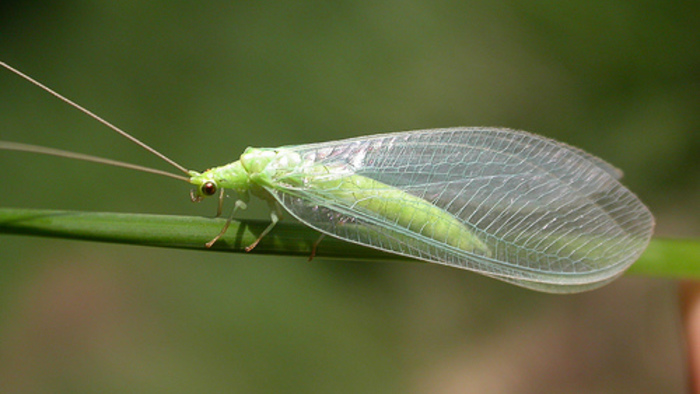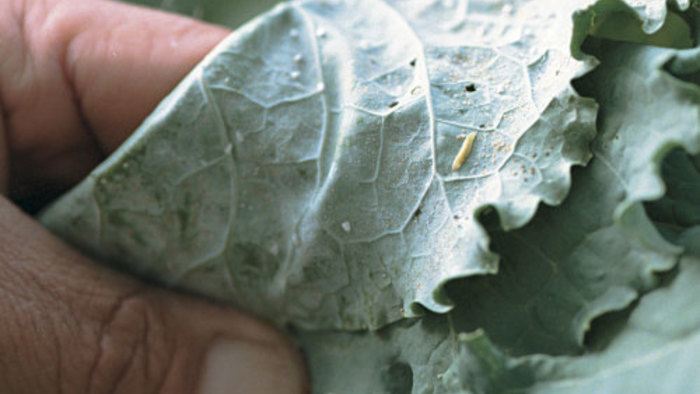by William Olkowski
Have you ever brushed against plants in your garden in the middle of summer and found yourself in what seemed like a snow flurry? Did hundreds of tiny, white, mothlike flying insects rise up suddenly around you, then just as suddenly disappear? No, it wasn’t a fluke of weather—you just agitated a group of whiteflies. If you’d taken a close look, you might have seen their younger scalelike stages, called nymphs, lying flat like small oval bumps against the undersides of leaves. These nymphs may be quite translucent and hard to see without a magnifying glass, but they are fringed with very fine, white, hairlike filaments.
It is primarily the pre-adult stages of whiteflies that cause direct damage to plants through their feeding, although adult whiteflies can also be a menace. Whiteflies have sucking mouth parts, as do aphids and scale insects, with which they pierce plant tissues to suck out sap. Foliage on troubled plants may turn yellow and dry out, leaving plants weakened and susceptible to disease.
Also like aphids and scales, whitefly nymphs produce honeydew, a sugar and protein excretion, from the plant sap they ingest. Black, sooty mold may grow on the honeydew, interfering with plant photosynthesis and marring the fruit. But perhaps most seriously, these insects can transmit plant pathogens like viruses through the puncture wounds they make. This potentially makes whiteflies more severe pests than their numbers or fragility might initially suggest.
There are more than 1,200 species of whitefly, but probably the most prevalent in the United States is Trialeurodes vaporariorum, commonly called the greenhouse whitefly. Despite its common name, the greenhouse whitefly feeds on outdoor vegetable plants like tomatoes, cucumbers, and potatoes, and many ornamental plants in gardens in southern and coastal areas of the United States.
Defense in the garden begins with diversity. Many plants can tolerate low numbers of whiteflies without sustaining enough damage to warrant treatment. To determine if natural enemies or other factors are keeping whitefly numbers low, check the undersides of older leaves about 4 in. to 6 in. below the newest top growth on the plant. When you first spot pre-adult whiteflies on the undersides of leaves, just pinch off the infested leaves. If you diligently do this when the plants are young, that alone may be sufficient to prevent a whitefly outbreak.
Your best protection against the build-up of large and potentially damaging populations of whiteflies in the garden is to have a wide variety, in small numbers, of both plant-feeding insects and their natural enemies present during the entire growing season. To maintain this diversity, keep pesticide use to a minimum because chemicals kill many beneficial insects. Spray only if whitefly numbers threaten to reach damaging levels. Yellowing or wilting plants are a sign of serious damage. Just seeing insects is not.
Keep beneficial insects around by providing them with nectar from flowering plants all season long. Showy flowers, like roses, are great for bees and other large-tongued insects such as syrphid or hover flies, whose larvae generally feed on immature whiteflies. More delicate parasitoids and predators prefer smaller, shallow-blossomed flowers including sweet alyssum, yarrow, dill, carrot flowers (leave a few carrot roots in the garden to bloom the second year), sweet fennel, and plants with daisy-like flowers. The adult stages of these beneficial insects often feed only on pollen and nectar from flowers, while their pre-adult stages feed on pest insects like whitefly nymphs.
Keeping the garden soil covered with organic mulches and compost will also help support a diverse insect, mite, and spider population. The idea is to give important whitefly predators protected daytime environments where they can hide and lay eggs. Compost is food for them in between night time meals of garden pests. Bare soil can make the garden a dry, hot, inhospitable place for many of the natural insect predators you are trying to encourage.
Help nature out by introducing beneficial insects. Early in the season, before many flowers are blooming and the naturally occurring beneficial insects have emerged or wandered in, you can help things along by purchasing and releasing natural enemies of the whitefly. For example, lacewings are one of the whitefly’s most effective natural enemies. Obtain lacewings in their larval stage from insectaries, rather than as eggs. Release the lacewing larvae on plants where you first notice whiteflies, and they should effectively control the emerging whitefly population. Once the lacewings reach the adult stage, they’ll fly to other plants in the garden seeking out whiteflies and other pest insects. Unlike some other beneficial insects like lady beetles, lacewings don’t usually wander and will remain in your garden, provided they have a food source.
Another natural enemy of the whitefly is a mini-wasp called Encarsia formosa. This tiny parasitoid searches out and kills pre-adult whitefly nymphs by laying its eggs inside them. Parasitized whitefly nymphs or scales turn black and are easy to see with the naked eye on the undersides of leaves. One black whitefly scale generally indicates that nearby scales have also been parasitized but have not yet turned black. Check the underside of the leaf again in a week. If more scales have turned black, you’ll know these little wasps are doing their part.
Use least-toxic pesticides with care. If natural or physical controls aren’t sufficient to solve your whitefly problem, there are a number of low-toxicity pesticides you can use. These include commercial insecticidal soap, refined oil sprays, and pyrethrum products. Read the labels carefully and follow all precautions. Or you can use a homemade spray made from garlic, mineral oil, and soap.
When applying a pesticide to kill whiteflies, it’s essential to focus on the undersides of leaves so the pesticide reaches the pre-adult whiteflies. To minimize impact on beneficial insects, spot-spray only the plants that have serious infestations.
Be wary of whiteflies indoors. Whiteflies favor warm climates and can be particularly troublesome indoors and in greenhouses. That’s because their natural enemies are usually excluded from protected indoor environments. Whiteflies often come indoors unobtrusively attached to a plant in their almost invisible scalelike form. In contrast, whitefly predators like spiders and lacewings are apt to be summarily smashed or shown the door if they wander inside.
Carefully examine newly purchased plants or those you’re taking care of for vacationing neighbors to make sure you’re not bringing in trouble. It’s a good idea is to set up a quarantine area, a room away from the rest of your plants where you can observe the new additions for several weeks before letting them join the rest of your indoor garden. When you’re tending your plants, work with the older plants first, and the newest last, so you won’t inadvertently carry pests on your arms or clothing.
If you do get an infestation indoors, there are several management options. If just a few leaves are infested with whitefly scales, remove and discard the leaves. Or dab the pre-adult whiteflies with a cotton swab dipped in rubbing alcohol.
If a plant is heavily infested, give it a bath: Fill a bucket or dishpan with soapy water, wrap a cloth around the surface of the pot to hold in the soil, invert the plant, slosh the foliage in the soapy water, and remove the plant from the water. After a few hours, wash off the plant in clear water.
You can also spot-spray infested areas of the plant with the commercial insecticides mentioned above. It’s always a good idea to test any pesticide on a small part of the plant first to ensure it doesn’t damage plant tissue.





















Comments
Log in or create an account to post a comment.
Sign up Log in